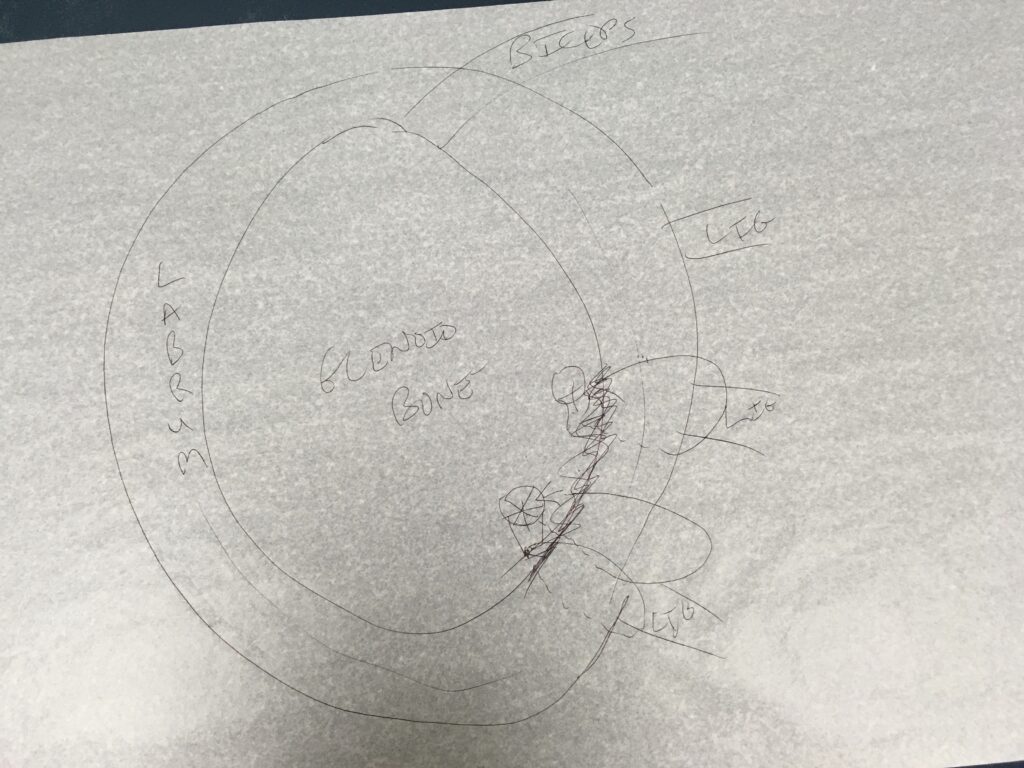On Tuesday morning it was very busy inside my shoulder. I don’t know exactly what it all looked like because I of course was under anesthetic and don’t have any memory of what happened from the moment they put some special medicine in the IV which in the words of the nurse who administered it “stops you caring about things”.
And sure enough it did. I drifted off and the next thing I knew I looked at the clock, saw it was 12 PM or there about and I knew that the surgery was done.
I have been amazed at how fast the recovery went compared to the last time I had surgery and full anesthetic. That was 25 years ago for the same shoulder. I was kept in the hospital for about five days at the time. This was not unusual back then (beds were available after all) but also I think science has made big progress, and there have been changes in how anesthetic is used and the recovery protocol. I felt most of the afternoon on Tuesday OK. There were (long) naps, but I was mobile, I was back home. I had a friend look after me, but it definitely was very different from the previous experience when I felt dizzy or nauseous and now I was just a little sleepy, and not hungry.
The main thing that I remember from Tuesday was that I was incredibly thirsty. My voice was hoarse and although it gradually became a bit better through the course of the day, they were fits of coughs and moments where I could really feel gunk coming up. That was the result of being intubated for about an hour during the procedure. This was five days ago and today (Saturday) is the first morning when I wake up and I don’t feel that. I also noticed that I used shallow breathing instead of regular abdominal breathing, but now I feel pretty good, and I think I have regained my full lung capacity. PSA: don’t get intubated if you can help it.
Two days after the surgery, you can take off the big dressing that is put over the stitches. Underneath you can see about four small incisions at the front and back of the shoulder. This is where the camera went in, the little arthroscope which is used to look inside the joint, and also all kinds of tools. As I said it was very busy in there. The main reason for the surgery was a labral tear that needed to be repaired and that required placing two small screws (anchors) on the side of the bone that forms the socket and then with a little lasso or loop attaching tendons from a muscle — as far as I understand it at least — to those little anchors. That should keep the ball of the joint of the shoulder better in the socket, and that will prevent future dislocations and stop it from feeling “loose” (and painful). But while you’re in there you might as well clean up. A little bit of a bone spur was shaved off with an electric shaver; I’m fascinated by that. And then there was a little bit of hoovering up of all the debris — or debridement as it’s called with a technical term, no one uses the word hoovering here I’ve noticed.

I got sent home with some very nice, strong painkillers, so I have not really been in any pain. Ice packs have also really helped to keep the pain under control. The first day it was 20 minutes of ice every hour on that shoulder. That really helps, even now I will regularly grab an ice pack.
The first two weeks I will be in a sling and not use my arm at all; at most moving around my fingers and my wrist a little bit, maybe stretch my elbow to maintain some range of motion. At the moment just taking the sling off for showering and then putting it back on while getting dressed or changing requires some thinking, because I need to keep my elbow close to my body at all times. That makes it very hard to put my arm in a sleeve, for instance. I can do it, but of course as with any injury or disability (temporary or permanent) daily life activities just take more time and energy and thought.
I have a follow-up appointment scheduled two weeks after surgery and then the next day I will start with physical therapy. I will have my arm in a sling for six weeks; total recovery is currently projected to be four months. I asked the surgeon how long it would take before I can play flute again. That is undoubtedly the thing I will miss the most over the coming few months and he said likely about three months. However he didn’t quite know how to hold a flute — and I could not show him because this was after the surgery. Because it was the most painful of all the activities I was still able to do before surgery, I think I’ll temper my expectations to closer to 3 1/2 or maybe even the full four months to be comfortable playing through an entire flute session of 45 minutes.
Let me know in the comments what you would like to hear more about as I recover from this surgery.
This post is brought to you by the power of Siri speech recognition and a lot of cleanup. Apologies for typos, weird sentence constructions, and other strange stuff that makes it hard to read.

👍een beetje geduld het komt snel goed. De kine zal je tijd wel vullen met oefeningen. 😀😘
indedrdaad!